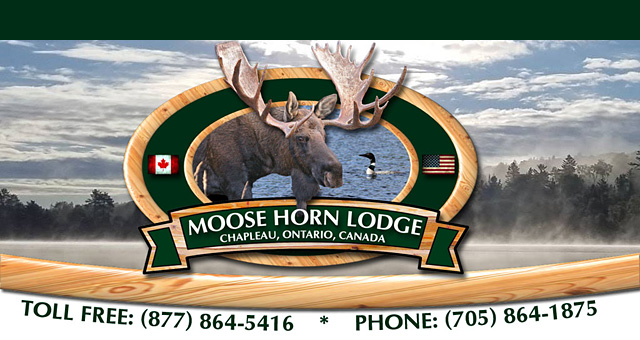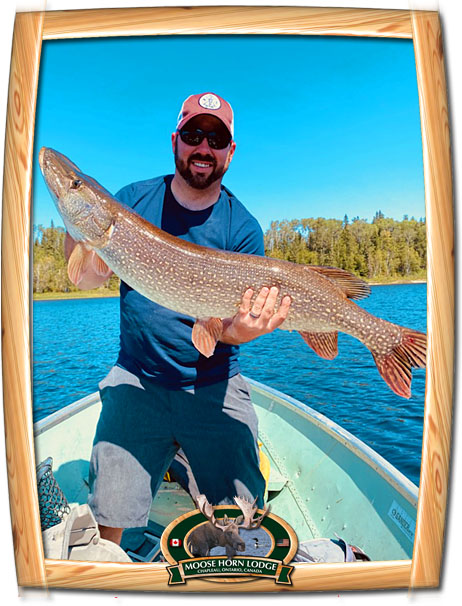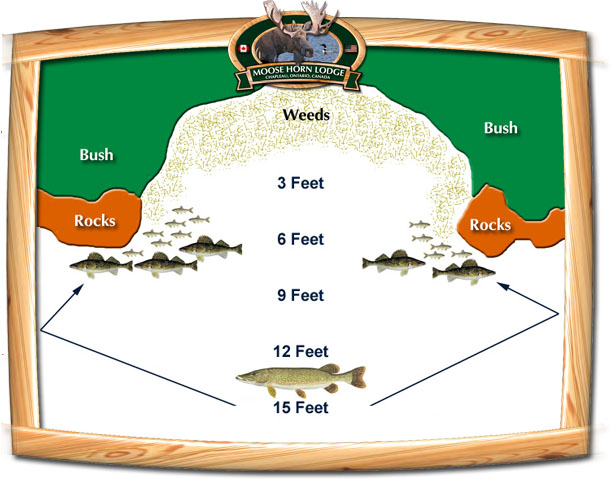


 Lakes in the Chapleau area are home to a healthy population of Northern Pike and also produce some big trophies. Northern Pike in the south grow much faster but with warmer water there are also more parasites so Northern Pike rarely get over 10 pounds before they parish. In the far north towards the tree line and into the arctic tundra it's the exact opposite. Northern Pike live to be very old and become larger because of the clean water but they also grow a lot slower because the water is so cold and unfertile. Chapleau seems to be in the goldilocks zone where Northern Pike grow fast and live to a ripe old age. With a high population of Whitefish in our local lakes the Northern Pike are well fed and can get big.
Lakes in the Chapleau area are home to a healthy population of Northern Pike and also produce some big trophies. Northern Pike in the south grow much faster but with warmer water there are also more parasites so Northern Pike rarely get over 10 pounds before they parish. In the far north towards the tree line and into the arctic tundra it's the exact opposite. Northern Pike live to be very old and become larger because of the clean water but they also grow a lot slower because the water is so cold and unfertile. Chapleau seems to be in the goldilocks zone where Northern Pike grow fast and live to a ripe old age. With a high population of Whitefish in our local lakes the Northern Pike are well fed and can get big.
Our lodge is located on McLennan Lake, which is a smaller lake and does have pike in it. On occasion, you can catch a nice size Northern Pike but that is not something that happens every week and not something you can expect.
If you are specifically looking for Northern Pike then you have a much better chance at one of the other lakes in the area. We have a dozen other Northern Pike lakes within a 10 to 60 minute drive from the lodge. Some of these lakes are remote and a little difficult to get to because they are on old logging roads, non-maintained roads or 4x4 trails but that adds to the adventure. Ideally if you want to take advantage of the fantastic Northern Pike fishing in the area you should have a pick-up truck, Jeep or SUV with a trailer hitch and 2-inch ball. 4x4 drive is an added bonus in the spring when some of the roads are muddy.
We can have boat caches on these Northern Pike lakes but due to the theft of some of our boats and motors in the past we changed to a new tactic. We have fishing boats on trailers ready to go. You just hook them up to your hitch and you are on your way. You can also bring your own boat.
Northern Pike in some of the bigger lakes do get big. Bigger lakes will produce high numbers and if you are targeting big Northern Pike and focusing on places where big Pike will ambush prey you have a very good chance of catching a big one. This is explained on our pike fishing tips page. Luckily attitudes are changing and everybody lets the big trophies go. Catch & release has had a huge impact on the trophy Northern Fishery everywhere in Ontario and every year guests are catching trophies more frequently.
The best time to fish for Northern Pike is around mid morning until late afternoon. As the sun starts to go down the angle of the sunlight is producing less light penetration into the water. At this time the Northern Pike slow down and even stop feeding. This is probably why the Walleyes start feeding.
When small to medium size Northern Pike are feeding they are the easiest fish to catch. They will hit just about anything and will venture into any kind of habitat if they think there is food. Guests catch them in the thick weeds, in the thin weeds and even off rocky points and shoals, where you would expect to catch Walleyes and Smallmouth Bass. Catching the big Northern Pike, big meaning 12 to 25 pounds, needs tactics that are a bit more refined.
Near the beginning of August most big Northern Pike start to take off into deep water in really deep lakes and by mid-august they can be really hard to fine. They will spend their time down along deep water ridges from 15 to 30 feet deep. You don't have to worry about that at our lodge because all our best Northern Pike lakes are fairly shallow. The feeding patterns and depths that the Pike are found at stay reliably the same all season. This Pike fishing tips article will mainly concentrate on shallow water tactics.
The one thing you must remember about large trophy Northern Pike is they are ambush predators. They are not like Muskie. Muskie are hunters and will cover great distances along the shore or weed beds looking for food. Northern Pike are ambush predators and very territorial. They will stake out a spot that is favorable to Walleyes, Smallmouth Bass and Perch and wait for the food to come to them. Let's examine these favorable spots.
A small bay with thick weeds along the back shore that drops off quickly into deep water once you venture out past the points is the absolutely best spot for a trophy Northern Pike. Waves push the surface water up against the point. As the water moves around the point it calms down and drops plankton and bugs, which in turn attracts small minnows. The big Northern Pike will site off into the deep darker water just outside the bay waiting for the minnows to attract Walleyes and Smallmouth Bass. When the Pike decides to strike the Pike will swim to the outside of the points and then turn inwards towards the bay thus minimizing the escape route of the Walleyes. (see diagram 1) In this situation you want to position your boat toward the center of the bay out over deep water within casting distance of the points. If the Pike is off in the deeper water in might take several casts before the splash of your lure attracts him to see what is going on at the points. If you don't get anything after a few minutes try casting straight into the bay and as the water gets deeper stop reeling from time-to-time and let your lure sink deeper. In this situation is better to use heavier lures that will sink such as Daredevles, Mepps Cyclops or heavy spinner baits with low friction blades.
 Another place big Northern Pike like to ambush prey is around open water weedy flats. What we mean when we say open water is weedy flats that are not way back in some stagnant part of the lake where there is no wave action to produce oxygen. These places also have higher nitrate levels thus the large Northern Pike will not be there. If an area looks swampy and there is no indication of a feeder stream cleaning the water and the bottom is just black muck then don't waste your time. You want to find a weedy flat that is out in the lake or has at least one side facing the open lake.
Another place big Northern Pike like to ambush prey is around open water weedy flats. What we mean when we say open water is weedy flats that are not way back in some stagnant part of the lake where there is no wave action to produce oxygen. These places also have higher nitrate levels thus the large Northern Pike will not be there. If an area looks swampy and there is no indication of a feeder stream cleaning the water and the bottom is just black muck then don't waste your time. You want to find a weedy flat that is out in the lake or has at least one side facing the open lake.
Let's say you find a flat plateau out in open water but the bottom is very different than the bay in diagram 1. It is six or seven feet deep all the way through with a flat bottom. There are intermittent patches of weeds and maybe a few patches of Wild Rice in a few areas that get shallow. You might even see some Lily Pads. This is an area where you should find lots of medium size Northern Pike and there is always a big one hanging around. Be very quiet and try casting spinnerbaits or crank baits in between the patches of weeds. In a spot where the weeds are getting thicker try casting a weedless Johnson Silver Minnow. In large weedy flats there is no recognizable structure to concentrate on. It's more of a matter of covering ground. If you do find deeper spots with darker water in the middle of these flats then that is a prime place for a big trophy Northern Pike to sit on bottom. In this case cast into the area and let your lure sink deeper and give it quick jerks while it sinks to look like an injured fish.
Big trophy Northern Pike are notorious for following your lure to the boat and then turning away or just sinking to the bottom. In this case drop your lure and try jigging it without looking over the side of the boat. You do not want to scare the Pike away. Sometimes they will sit under the boat and will not go after your lure until they see a smaller Pike go after it so it may take a few minutes. Do not put your rod in the water and do figure eights. That is TV folklore and will scare the Pike away. It may work on smaller Pike but a big Northern Pike is big because he is old and he is old because he is smart.